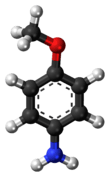p-Anisidine
| |||
| Names | |||
|---|---|---|---|
| Preferred IUPAC name
4-Methoxyaniline | |||
| Other names
p-Anisidine (no longer recommended[1]) | |||
| Identifiers | |||
| 104-94-9 | |||
| 3D model (Jmol) | Interactive image | ||
| ChEMBL | ChEMBL295652 | ||
| ChemSpider | 13869414 | ||
| ECHA InfoCard | 100.002.959 | ||
| EC Number | 203-254-2 | ||
| KEGG | C19326 | ||
| UNII | 575917SNR4 | ||
| UN number | 2431 | ||
| |||
| |||
| Properties[2] | |||
| C7H9NO | |||
| Molar mass | 123.15 g/mol | ||
| Density | 1.071 (57 °C) | ||
| Melting point | 56 to 59 °C (133 to 138 °F; 329 to 332 K) | ||
| Boiling point | 243 °C (469 °F; 516 K) | ||
| soluble | |||
| Solubility | soluble in ethanol, diethyl ether, acetone, benzene | ||
| Vapor pressure | 0.006 mmHg (25 °C)[3] | ||
| Refractive index (nD) |
1.5559 | ||
| Hazards | |||
| Flash point | 122 °C (252 °F; 395 K) | ||
| 515 °C (959 °F; 788 K) | |||
| Lethal dose or concentration (LD, LC): | |||
| LD50 (median dose) |
2900 mg/kg (rabbit, oral) 1300 mg/kg (mouse, oral) 1400 mg/kg (rat, oral)[4] | ||
| LDLo (lowest published) |
1000 mg/kg (mouse, oral)[4] | ||
| US health exposure limits (NIOSH): | |||
| PEL (Permissible) |
TWA 0.5 mg/m3 [skin][3] | ||
| REL (Recommended) |
TWA 0.5 mg/m3 [skin][3] | ||
| IDLH (Immediate danger) |
50 mg/m3[3] | ||
| Related compounds | |||
| Related compounds |
o-Anisidine m-Anisidine | ||
| Except where otherwise noted, data are given for materials in their standard state (at 25 °C [77 °F], 100 kPa). | |||
| | |||
| Infobox references | |||
para-Anisidine (p-anisidine), a grey-brown solid, is the most toxic[5] of the three isomers of anisidine and causes blood damage upon oral ingestion, inhalation or skin contact. If heated strongly, it may release very toxic fumes of nitrogen oxides.
p-Anisidine reacts with secondary oxidation products such as aldehydes and ketones in fats and oils to form products that absorb at 350 nm wavelength of light; therefore, it is used as an official method for detecting them by the American Oil Chemists' Society.[6] It is particularly good at detecting unsaturated aldehydes, which are the ones that are most likely to generate unacceptable flavors, making it particularly useful in food quality testing.[7]
References
- ↑ Nomenclature of Organic Chemistry : IUPAC Recommendations and Preferred Names 2013 (Blue Book). Cambridge: The Royal Society of Chemistry. 2014. p. 669. doi:10.1039/9781849733069-FP001. ISBN 978-0-85404-182-4.
The names ‘toluidine’, ‘anisidine’, and ‘phenetidine’ for which o-, m-, and p- have been used to distinguish isomers, and ‘xylidine’ for which numerical locants, such as 2,3-, have been used, are no longer recommended, nor are the corresponding prefixes ‘toluidine’, ‘anisidino’, ‘phenetidine’, and ‘xylidino’.
- ↑ Weast, Robert C., ed. (1981). CRC Handbook of Chemistry and Physics (62nd ed.). Boca Raton, FL: CRC Press. p. C-98. ISBN 0-8493-0462-8..
- 1 2 3 4 "NIOSH Pocket Guide to Chemical Hazards #0035". National Institute for Occupational Safety and Health (NIOSH).
- 1 2 "p-Anisidine". Immediately Dangerous to Life and Health. National Institute for Occupational Safety and Health (NIOSH).
- ↑ http://www.sigmaaldrich.com/catalog/product/aldrich/a88255?lang=de®ion=DE
- ↑ "AOCS Official Method Cd 18-90". American Oil Chemists' Society. Retrieved 26 February 2013.
- ↑ Steele, Robert (2004). Understanding and Measuring the Shelf-Life of Food. Woodhead Publishing in Food Science and Technology Series. Woodhead Publishing. p. 136. ISBN 1855737329.
External links
- International Chemical Safety Card 0971
- "NIOSH Pocket Guide to Chemical Hazards #0035". National Institute for Occupational Safety and Health (NIOSH).
This article is issued from Wikipedia - version of the 10/31/2016. The text is available under the Creative Commons Attribution/Share Alike but additional terms may apply for the media files.

